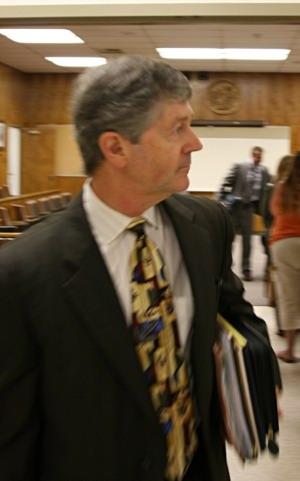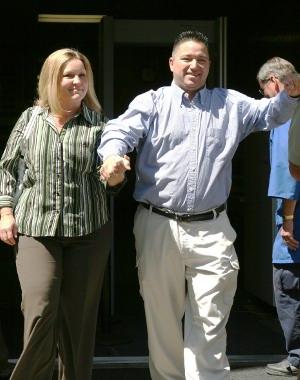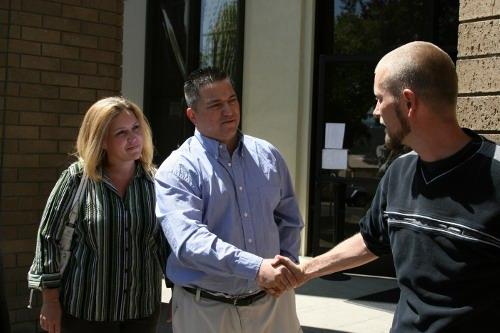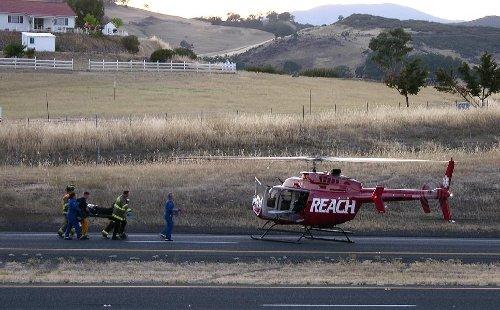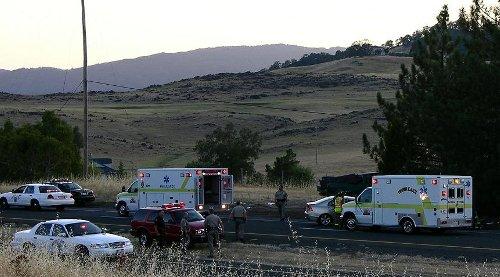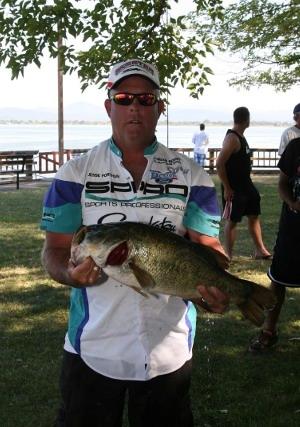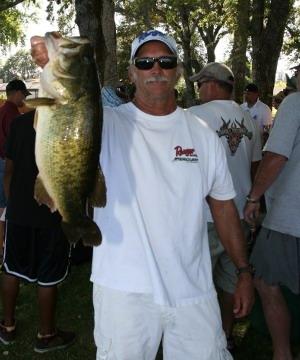LAKEPORT – Allegations of corruption and bias contrasted with arguments attacking the conclusions of key defense witnesses were the major themes during closing arguments in a Carmichael man's trial for felony boating under the influence.
Family, friends and supporters looked on as Bismarck Dinius, 41, sat through the day-long arguments in Lake County Superior Court's Department One, with District Attorney Jon Hopkins and defense attorney Victor Haltom exchanging verbal barbs and challenging each other's conclusions.
On the evening of April 29, 2006, Dinius was steering the Beats Workin' II, a sailboat owned by Willows resident Mark Weber, when it was hit by a powerboat driven by Russell Perdock, an off-duty chief deputy sheriff.
Dinius is accused of felony boating under the influence with great bodily injury and two lesser included offenses of boating with a blood alcohol level over 0.08 and boating while under the influence.
Weber's girlfriend, 51-year-old Lynn Thornton, was injured and died three days later. Perdock was not charged, but Dinius is on trial because Hopkins alleges that Dinius was under the influence of alcohol and had a duty to see the boat's lights were on.
The defense has argued throughout the trial that Dinius was merely a crew member on Weber's boat, the lights for which were on until the collision knocked them out, Haltom argued.
In close to three hours of arguments on Tuesday, Hopkins hammered away on responsibility and proximate cause.
Haltom, whose closing arguments lasted just minutes short of an hour, offered a passionate summation to the jury, accusing the sheriff and district attorney's offices of bias, corruption and incompetence, and urging the jury to teach local officials a lesson by handing down a correct verdict, which would acquit his client.
Trial's last witnesses heard
Closing arguments got under way after Judge J. Michael Byrne denied a motion to release Perdock's personnel records as well as information from an internal affairs investigation, in which Perdock is facing a misconduct allegation.
That decision followed a brief hearing in which Perdock's attorney, Alison Berry Wilkinson, argued strenuously against the motion.
Before making the decision, Judge Byrne went into chambers with Deputy County Counsel Ryan Lambert, Capt. James Bauman of the Lake County Sheriff's Office, a court clerk and the court reporter. He emerged to say he found nothing discoverable for the purposes of Dinius' case.
Both Hopkins and Haltom called brief rebuttal witnesses, beginning with Hopkins presenting April Aalto, a registered nurse who worked on a REACH air ambulance the night of the crash.
Aalto said the helicopter was called to Konocti Harbor Resort & Spa on April 29, 2006, to pick up a patient for transport, but no ambulance arrived and they did not transport a patient.
That testimony contradicts a statement made by defense witness Dennis Olson, a former Konocti Harbor security employee who recalled an ambulance and a patient arriving at a landing zone he helped set up.
Aalto also noted that a flare used to light up the landing pad rolled down the hill and she was afraid it was going to start a fire. Olson said he and another employee had used sandbags to keep the flares weighed down.
The helicopter returned to its base at Lampson Field after leaving Konocti Harbor, said Aalto. Early on the morning of April 30, 2006, they were summoned to Sutter Lakeside Hospital where they picked up Thornton and transported her to David Medical Center.
Hopkins also called Tom Clements, a detective sergeant with the Clearlake Police Department who had previously retired from the agency and, for a time, was working as an investigator for the District Attorney's Office.
In April of 2007 Clements conducted two phone interviews with Brian Stole, a witness who said he saw the crash while standing on a grassy knoll at Bayview Estates.
Stole told Clements he heard Perdock's powerboat coming around Fraser Point, saw its red and green bow lights and estimated its speed at about 45 miles per hour.
In a subsequent interview Clements said Stole stated that he saw a white or yellow light and a green light on an object that he thought was a dock, which merged with the powerboat.
Initially Stole estimated the distance to the crash from shore was five to 10 miles; in the second interview he estimated 500 yards. Stole said he wasn't drinking alcohol when he saw the crash.
Haltom asked Clements if he told Stole the interview was being recorded, and Hopkins objected to the relevance. Byrne allowed Clements to answer. He said he didn't remember telling Stole that, but he usually informs interviewees of recordings.
Haltom asked Clements his relationship to Perdock. He said he's known him professionally during the 12 years he's worked for Clearlake Police. Clements said he's not a member of the local Masonic Lodge to which Perdock belongs.
Did Stole tell him that he estimated the powerboat's speed to be between 45 and 50? Haltom asked. “I remember him saying 45,” said Clements.
Haltom asked if Clements disputed that in the recording Stole also said 50. Clements said he doesn't know why he wouldn't have noted that had Stole said it.
Hopkins asked if Stole used the word “merge” to recall the lights coming together. “I don't recall,” said Clements.
Haltom asked if Stole said the lights “came together.” Clement said yes.
The final rebuttal witness was Jean Strak, who had testified earlier in the trial to seeing the sailboat leave Richmond Park Bar & Grill with its lights on. She also stated a sheriff's deputy came to her tanning salon on Soda Bay Road to interview her, but no report about her interview was ever filed, according to Hopkins.
Haltom asked if she was interviewed by deputies about two separate incidents? Yes, said Strak. In addition to the boat crash, she was interviewed about a bar fight during which she was assaulted by a male subject at Richmond Park in May of 2006.
Hopkins asked her when she was interviewed about the bar fight. She said it was around midnight at the bar. “I was in the wrong place at the wrong time and a guy hit me.”
How many deputies talked to her? Hopkins asked. She didn't know. He asked if three deputies spoke to her. She said she didn't know, she had been hit in the face, was bleeding and not paying attention. Had she been drinking that night? “I had a couple,” she said.
Strak said she later received four or five phone calls from deputies about the fight. For a time in May of 2006 she was in Mexico on vacation and when she got back was contacted by deputies again.
An insurance investigator also called her about the boat crash, said Strak, and she also spoke to a deputy about it. “I heard nothing else ever again until two months ago.”
She said her friend Julie Knight was at her salon at one point and talked to an investigator.
During a brief break between the final rebuttal witnesses and the beginning of closing arguments, Haltom attempted to enter a piece of evidence which Hopkins objected to due to foundation, and Byrne sustained it.
Haltom also renewed his motion to have Dinius acquitted from the charges based on the question of whether he had a duty to turn on the lights. Byrne denied the motion.
Hopkins questions experts as he presents final arguments
Hopkins presented his closing arguments over an hour and 15 minutes in the morning session.
He began by talking about jurors' obligations and the prosecution's burden to prove the case beyond a reasonable doubt.
“That is not a standard that is legal mumbo jumbo,” Hopkins said of the reasonable doubt concept. “It's really one that can translate into everyday life.”
He told the jurors that they must have an abiding conviction that the charges are true, but they don't have to eliminate all doubt, since everything in life is open to some degree of doubt.
In convicting Dinius Hopkins said he must prove that Dinius operated the vessel, that he operated it under the influence of an alcoholic beverage, that he neglected the performance of a legal duty – in this case, having the lights on – and that his failure to perform his duty led to bodily injury.
Those four elements “all kind of fit almost in a ladder – one leads to the next. All four must be proven,” Hopkins said.
He said they have heard testimony from several people that Dinius was operating the boat. He recalled Jim Ziebell's testimony, which included an account of being the helmsman on Weber's sailboat during the Konocti Cup earlier on the day of the crash.
“Steering the sailboat is not just a simple task,” said Hopkins, noting there are complexities, including considering the wind and sails.
Ed Dominguez and Zina Dotti, who were on the sailboat that night, stated Dinius was at the tiller, while Weber was sitting on a step facing them and away from the front of the boat. Dinius himself said he occasionally stood up to see over the cabin and was watching the wind indicator, said Hopkins.
Witnesses also had described Dinius as drinking, and Dinius also said he was, said Hopkins. Three hours after the collision he still had a blood alcohol level of 0.12, one and a half times the legal limit, which meant that additional alcohol had been in his system at the time of the crash, he said.
On the issue of what Dinius had to drink, Hopkins said, “The exact number is not important. What's important is he was above a .08, and that makes him under the influence.”
A sober person would be aware of all conditions on lake around them, said Hopkins. Dinius had a responsibility to exhibit the sailboat's lights, just as a person who got into another person's car would have a responsibility to turn on the lights when driving.
Dinius should not have taken the tiller while impaired, and he should have checked the lights, said Hopkins, suggesting that Dinius could have turned around and leaned over from his position at the tiller to see if the stern light was on.
“He's using this vehicle, he's required to make sure he does not neglect the duties put upon him by law,” Hopkins said. “The issue then goes next to whether lights on sailboat were off or on.”
Different people saw the boat's lights when it went out. “It is clear that some kind of light was on,” said Hopkins.
However, they didn't see the crash and no witnesses saw the sailboat past Little Tule Point, about halfway up the shore of Konocti Bay, with lights on, he said.
Dominguez, Dotti and Dinius didn't recall the stern light, but they did remember the cabin lights, said Hopkins. Only Weber, who testified to saying, “We've got lights, let's go,” claimed to have seen them, but no one testified to hearing Weber make that statement. Hopkins also pointed to discrepancies in whether or not they sailed out or motored out, an issue which may be a matter of intoxication or focus of witnesses.
Two hours after the crash, Weber had a blood alcohol level of 0.18, added Hopkins, suggesting Weber may have knocked the running lights switch off when he went down into the cabin in his inebriated state.
Weber later would call Dinius and ask if the lights were on, Hopkins noted.
“People do go out on the lake at night and turn off their lights,” especially if it's a pleasure cruise and they think that no one else is out there. Perhaps the famous Lake County gnats were getting into the wine glasses, Hopkins suggested.
Perdock and James and Jordin Walker don't see the sailboat lights, neither did witnesses on shore who heard and saw the powerboat, Hopkins said. Two fishermen, Colin Johnson and Anthony Esposti, saw a sailboat without lights, and heard laughing and talking, as did teenager Jennifer Patterson, who was watching from shore.
“It's crucial that a vessel be lighted appropriately so everyone knows what everyone else is doing,” he said.
Hans Peter Elmer, a retired policeman who saw the crash from the Young Scandinavians Club, thought the boat was going fast because he saw it on a 45-degree angle, but Hopkins said others saw the boat leveled out and on plane. “He thought it was going really fast because of its noise.”
Elmer and the fishermen all saw Perdock's boat because of the running lights. "It was a very dark night but it was clear,” said Hopkins.
They also saw the powerboat collide with something that wasn't lit, he said.
Stole, who saw the boats lights merge before the collision, was “a little confused,” said Hopkins, who suggested that Stole really saw the lights of the fishing boat carrying Esposti and Johnson, not the sailboat's lights.
Hopkins pointed out that Stole did not say he saw that crash. “There is not a reliable witness that saw the sailboat lights on at the time of the collision.”
Doug Jones was the last person to see the sailboat with lights as it went past Little Tule Point. Hopkins said most of the witnesses testified to seeing the cabin lights on, but those don't justify the legal requirement for lighting.
Hopkins faulted defense expert Dr. William Chilcott, who had criticized Department of Justice criminalist Toby Baxter's work on the sailboat light filaments. Hopkins said Chilcott, in his written report on the case, never suggested that a stretch in the filaments was due to a manufacturing process. Rather, Chilcott said it was due to the lights being on.
Chilcott also didn't trace pulled out wires on the sailboat to the stern light, which is where he stated they went, said Hopkins.
“Dr. Chilcott was clearly not objective in this case,” said Hopkins. “He clearly had a bias.”
There also isn't support for Chilcott's theory about the wires being pulled out, causing the lights to go out, argued Hopkins. “It doesn't really matter how famous he is” if he doesn't have the facts, Hopkins said of Chilcott.
Hopkins said that Dinius had a duty to exhibit the boat's lights. “But for the lights being off, this collision does not occur, so it's a direct result,” he said.
Is it likely someone will run into you if the lights aren't on? “The answer is of course, there's no question about it,” said Hopkins, explaining that it's totally forseeable that a power boat will run into another unlighted boat.
“If there is more than one cause, then Mr. Dinius' failure to have lights on has to be a substantial factor,” said Hopkins, noting there can be several causes.
Are there other negligent people involved? Hopkins asked. “It doesn't matter,” he said, answering his own question.
Perdock and Weber both can be negligent but Dinius' alleged negligence is the substantial factor, he said.
Defense: Wrong man on trial
Hopkins rested at the end of the morning session, with Haltom beginning his closing arguments after lunch.
“This case is, more than anything else, a tragedy,” Haltom began.
He asserted that Hopkins “has turned this into a travesty” by prosecuting the wrong man – Dinius – while Perdock was not charged.
Haltom said he would present evidence of rampant corruption, bias and incompetence in the upper echelons of the county's sheriff's and district attorney's offices.
Using a PowerPoint presentation, one of his screens had the words “Russell Perdock is a liar” in large, bold white letters.
Haltom said the jury could help people in the sheriff's and district attorney's offices learn the difference between right and wrong by acquitting Dinius.
He said the issue of bias was obvious. Perdock, the No. 2 man in the Lake County Sheriff's Office, could affect the promotions and pay of his subordinates.
“He was treated with kid gloves from the get go,” said Haltom, noting that Sheriff Rod Mitchell hugged Perdock at the crash scene. He also alleged that mention of the sheriff's presence at the scene later was removed from reports.
He referred to former sheriff's Sgt. James Beland's testimony that he was ordered at the scene not to give a breath test, and cited the Masonic Lodge membership shared by John Flynn, one of Hopkins' investigators, and Perdock.
Haltom said Dinius is a good man who should not be on trial, but that it's Perdock who should be prosecuted.
In giving examples of corruption, Haltom said the sheriff's office failed to report contacts with witnesses who saw the sailboat's lights on, specifically Jones and Strak.
He also raised the issue of Perdock having access to evidence facilities where his blood sample and the boats were kept. Haltom said the prosecution provided no evidence about where Perdock was the day after the crash – a Sunday – during which there was a 16-hour interval that he had access to the blood sample. He said Perdock has stated that he was home at the time.
“He has absolutely no credibility in this case,” Haltom said, explaining to jurors that the judge will give them instructions on discounting testimony of witnesses who don't give credible statements.
“He lied to you all, from that stand, about going to Konocti (Harbor),” Haltom said.
Perdock wasn't walled off from the investigation, said Haltom. He received an October 2006 e-mail from a sheriff's office employee that included copies of the 911 records. Richard Higinbotham, a former Lake County District Attorney's Office investigator, testified that in September 2008 he interviewed Perdock, who Haltom said “wanted to have a say in what was going on in this investigation.”
On the stand Perdock denied talking about speed and lights with Higinbotham, who Haltom said impeached that testimony point by point.
“We're not playing nice here, this is hard ball,” said Haltom.
He charged local officials with incompetence in carrying out their investigation.
Boat Patrol Supervisor Sgt. Dennis Ostini admitted his mistakes in leaving the sailboat unattended for several hours at the Boat Patrol facility, said Haltom. “That's a critical item of evidence in this case,” he said. “It was tainted from the get go.”
Then-Sgt. Charles Slabaugh from the Sacramento County Sheriff's Office was brought into the investigation. “Did you hear anything about the result of Lt. Slabaugh's accident reconstruction investigation? You heard zip,” said Haltom. “You ought to ask yourselves why.”
Slabaugh didn't conduct interviews, only speaking with Perdock and Elmer, Haltom said.
With the exception of retired engineer Richard Snyder, Haltom said all of the prosecution's experts were either incompetent or unfamiliar with sailing. One of them, state Department of Justice criminalist Gregory Priebe, admitted to having sunk a sailboat. Still others who testified about electricity couldn't explain the difference between direct current and alternating current.
“That is the essence of incompetence,” Haltom said.
But the maddening part of the case, said Haltom, is that investigations into the allegations against Dinius were still going on during the trial – three years after the crash – with the evidence's integrity damaged by the length of time.
Going point by point, Haltom accused Perdock of lying about everything from fixing his son breakfast on the day of the crash to not telling the truth about going to Konocti Harbor, where Haltom alleged he was drinking.
Haltom said he presented several witnesses that placed Perdock at the resort in the hours before the crash, including John Jansen, who testified to seeing Perdock at the resort and racing boats with him later. Haltom said Jansen's statements linked other witness testimony, and also revealed, in Haltom's opinion, another motivation for Perdock to drive fast that night, after being “blown away” by Jansen's boat.
While Perdock denied reviewing official sheriff's reports, Haltom said Sgt. Dave Garzoli testified to finding Perdock's initials in the main report's audit trail. Haltom also accused Perdock of lying about seeing the green glow of his bow light off the sailboat before the collision. At the angle he was approaching, the bow light reflection would have been red.
“He's got so many lies going he can't keep them all straight,” Haltom said.
Quoting a US Supreme Court Case, Duncan v. Louisiana, Haltom explained the importance of juries. That 1968 decision guaranteed the right to trial by jury in order to avoid government oppression and address fears of unchecked power. “That's why you all are here.”
It was Perdock who broke numerous navigational rules, said Haltom, from failing to have a lookout to traveling a safe speed.
Addressing the charges against Dinius, Haltom told the jury there's a very simple way to decide the case: “If you find the lights were on, you acquit – that's it.” They must ask themselves if Hopkins proved beyond a reasonable doubt that the lights weren't on, which Haltom suggested he hadn't done.
Haltom challenged Hopkins' assertion that Stole saw the lights of the fishing boat and not the sailboat when he saw the crash, and called Hopkins' suggestion that Weber could have hit the lights in the cabin and turned them off as an “Alice in Wonderland, chasing the white rabbit theory.”
While Haltom said Dinius was drinking that night, he said Dinius' sobriety had nothing to do with the crash, which he attributed to Perdock driving at “an absurd speed.”
Haltom said Dinius also was innocent of the lesser charges of boating under the influence and boating under the influence with a blood alcohol level above 0.08.
Haltom told the jurors that they get to decide between what's right and what's wrong in the case.
“Russell Perdock needs to learn that he doesn't own Clear Lake and he cannot escape responsibility for taking Lynn Thornton's life,” said Haltom, adding that Perdock isn't above the law because he has a badge, and that Dinius is the patsy in the case.
“Lynn Thornton deserves a just result in this case,” he said.
District attorney attacks “sales pitch” defense
As he began his rebuttal arguments, Hopkins told the jury, “I feel like I've been through an advertising pitch.”
Throughout his rebuttal statements, which included a point by point response to Haltom, Hopkins would liken Haltom's arguments to taglines and advertising jargon.
He questioned how he could prosecute Perdock on the accusations Haltom made.
“There's this huge allegation that there's bias, corruption, incompetence, liars, the wrong man on trial and therefore throw this whole thing out,” said Hopkins.
He denied the sheriff's hugging Perdock was a sign of bias. Hopkins reminded the jury of the tragic circumstances that night. He said they knew someone was dying as a result of the crash.
Addressing the allegations about Beland and the breath testing, Hopkins said, “As a prosecutor I wish all three of them ” – Dinius, Weber and Perdock – “had been immediately tested.”
Perdock wasn't given a pass, said Hopkins. When Hopkins' investigator, John Flynn, interviewed Perdock in May, “it was downright confrontational,” with Flynn challenging Perdock's time line for April 29, 2006.
The community is a small one, said Hopkins, with many people belonging to the same clubs – such as the Masons, to which both Perdock and Flynn belong – and churches, but that doesn't amount to bias.
Perdock may have had keys to the evidence facility, but based on the testimony of state Department of Justice criminalists, who testified about how they opened the blood evidence, there is no signs of tampering, said Hopkins. “The whole thing is absurd.”
Hopkins challenged Haltom's witnesses, including Joe Glebe, Konocti Harbor's security director, who at first didn't remember seeing Perdock at Konocti Harbor before testifying that he did, and Peter Erickson, who said he heard Perdock at the scene talking about having a soda at Konocti Harbor before heading to Richmond Park. “He's soda hopping? That doesn't make a whole lot of sense,” Hopkins said.
Erickson was angry in his testimony, and “angry at a number of things,” said Hopkins. “He's a biased witness.”
As to the value of Jansen's testimony, Hopkins said his statements contradict those given by Donna Perdock, Russell Perdock's ex-wife, and Olson. He suggested Jansen was listening to his buddies popping off about racing Perdock and decided to make up his own story to get on television.
Hopkins suggested that if two boats are in a collision, they both have an obligation, which raised an objection from Halton. Byrne said he would allow the comment but not for theory.
Hopkins spent time questioning Stole's testimony, reiterating his belief that Stole saw the fishing boat's lights, not those of the sailboat. Hopkins questioned if he could rest a prosecution on Stole's testimony.
Dinius had an obligation under law to exhibit side and stern lights, said Hopkins. “He never checks at all,” despite sitting next to it. Hopkins objected, saying Hopkins was misstating the evidence. Byrne overruled.
Despite his statement that he was down in the cabin, Weber was found knocked out on the sailboat's deck, which led Hopkins to argue that Weber's recollection of that night went away due to his injuries.
Esposti and Johnson came across an unlighted sailboat, saw a mast but not a sail. “There's no other sailboat out there,” Hopkins said. “There's certainly no other sailboat without its lights on.”
Hopkins noted that he was getting to the end of his notes, when one man said “Good!” loudly from the audience.
Based on an estimate from Snyder, Hopkins said Perdock's powerboat was going between 37 and 48 miles per hour, which launched it up and over the sailboat.
Snyder's studies on crashes found that at 20 miles per hour a powerboat would ramp up and slam down onto another boat and stay there. Even at 20 miles per hour there might have been more injuries and deaths, Hopkins suggested.
Whose fault is it if the lights go out? The operator's, said Hopkins.
“This safe speed thing” has been talked about as a rule, and Hopkins said it's similar to getting into a car. If you run into someone you're not going a safe speed, unless you come upon a drunk driver driving slowly on a blind curve with their lights off.
Hopkins told jurors they can't use sympathy for Lynn Thornton to decide the case. “You're supposed to look at the evidence.”
Jury to begin deliberations Wednesday
At the conclusion of closing arguments, Byrne told the jurors he would give them the instructions Wednesday morning, when they return at 9 a.m. He credited them with paying attention during the case.
After the jurors were gone Byrne praised both the defense and prosecution for their work, saying they'd both acted professionally.
“I think it was a well-tried case,” said Byrne.
“I take it you haven't made up your mind yet,” said Hopkins, which hearkened to Byrne's admonishment to the jury to keep open mind.
“Nobody asked me about my opinions,” Byrne said with a smile.
E-mail Elizabeth Larson at This email address is being protected from spambots. You need JavaScript enabled to view it. . Follow Lake County News on Twitter at http://twitter.com/LakeCoNews .



